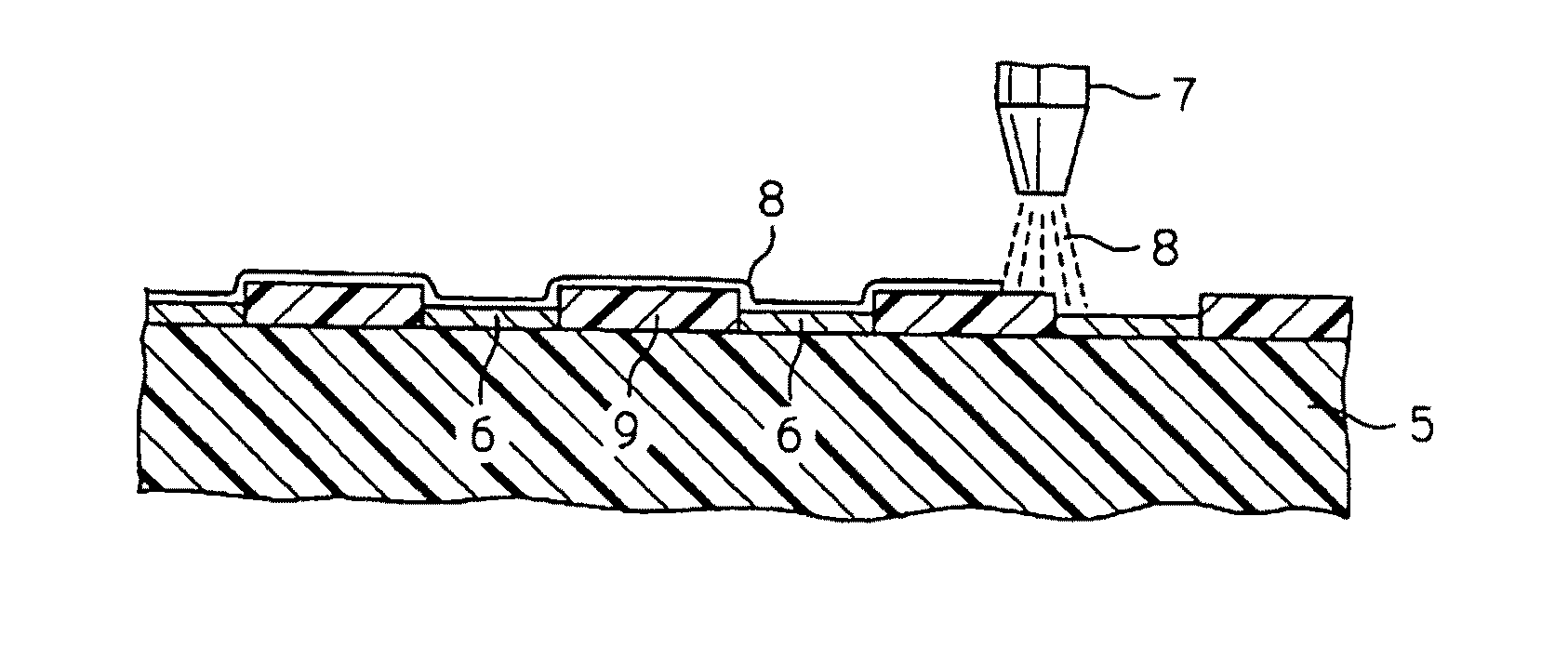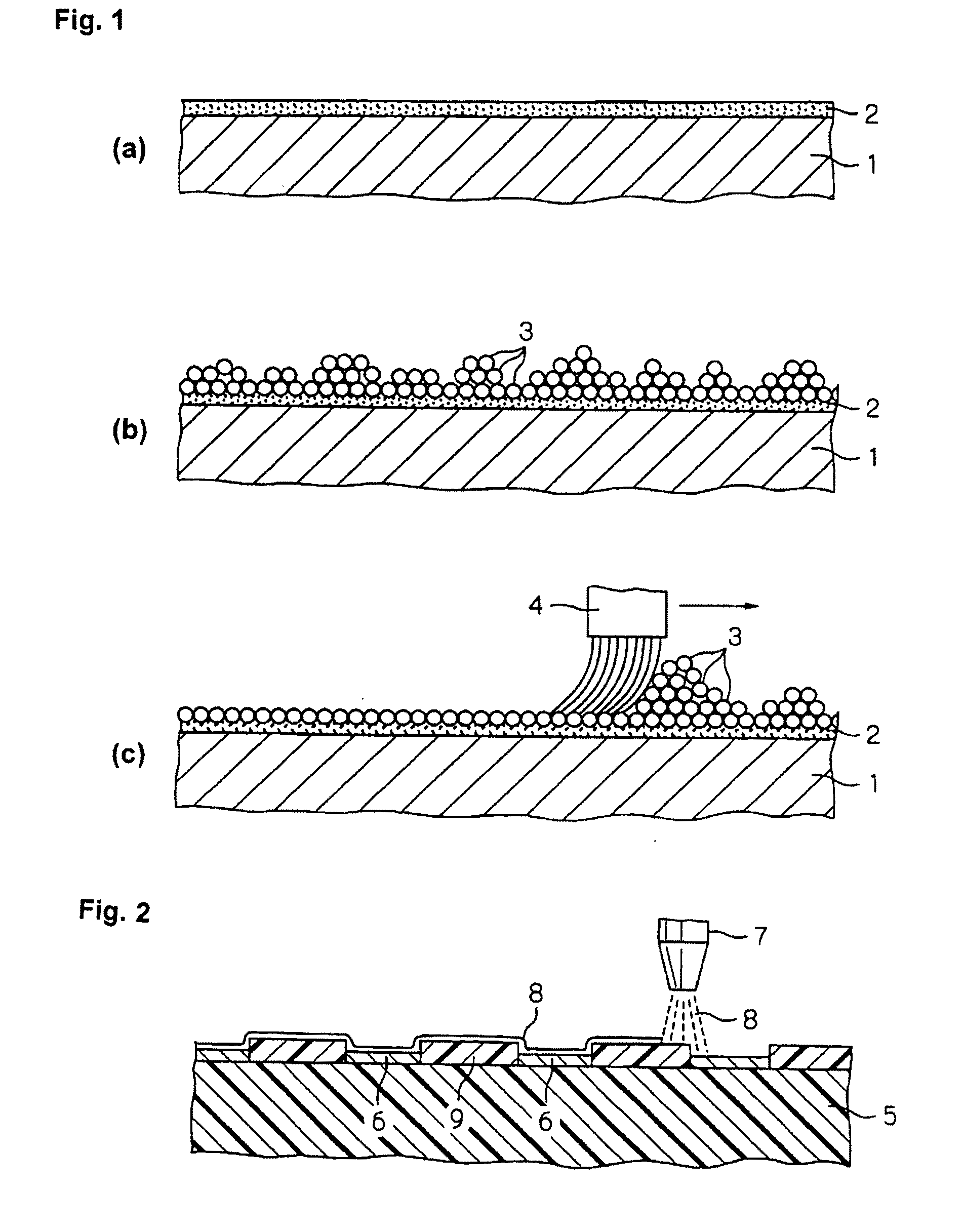Solder bump formation on a circuit board using a transfer sheet
a transfer sheet and circuit board technology, applied in the field of forming solder bumps, can solve the problems of bridging between the electrodes, too much solder on the electrode portions, and excessive amount of solder, and achieve the effect of reducing the size of electronic equipmen
- Summary
- Abstract
- Description
- Claims
- Application Information
AI Technical Summary
Benefits of technology
Problems solved by technology
Method used
Image
Examples
first embodiment
[0049]In a first embodiment of the present invention, a solder transfer sheet has a solder layer which is a solder particle layer formed from solder particles distributed in the form of a monoparticle layer. FIGS. 1(a)-1(c) are explanatory views showing a series of steps in a method of manufacturing a solder transfer sheet having a solder particle layer. A method of manufacturing this solder transfer sheet is the same as the method described in above-mentioned Patent Document 2, and it includes a step of forming an adhesive layer atop a supporting substrate (FIG. 1(a)), a step of dispersing solder particles atop the adhesive layer to adhere the solder particle layer to the adhesive layer (FIG. 1(b)), and a step of removing solder particles which are not adhered to the adhesive layer (FIG. 1(c)).
[0050]First, an adhesive layer 2 is formed atop a supporting substrate (FIG. 1(a)). The supporting substrate 1 is made from a material to which solder does not readily adhere and which has he...
second embodiment
[0093]In a second embodiment of the present invention, a solder transfer sheet has a solder layer in the form of a continuous coating of a solder alloy. Below, the second embodiment of the present invention in which a solder layer is a continuous coating will be explained for the case in which the portions to be soldered of a circuit board have a surface made of Au. However, the portions to be soldered may have a surface of a metal or alloy other than Au such as Cu. In this case, an oxide film is present on the surface of the portions to be soldered, so the oxide film can be previously removed prior to bonding, or the above-described solid phase bonding flux can be provided at the bonding interface.
[0094]Electrodes of a circuit board which are soldered using a lead-free solder often have an Au plating layer provided atop an underlying Ni plating layer, so the surface of the electrodes is made of metallic Au. This type of electrode will be referred to below simply as an Au-plated ele...
example 1
[0131]This example illustrates the formation of solder bumps using a solder transfer sheet having a solder layer in the form of a monoparticle layer of solder particles.
[0132]A commercially available adhesive sheet (SBHF manufactured by Panac Industries, Inc.) having an adhesive layer with a thickness of 25 μm formed from an acrylic adhesive on one side of a polyester film (polyethylene terephthalate) with a thickness of 50 μm was cut to a size of 100×100 mm and used as a supporting substrate having an adhesive layer. The adhesive strength of the adhesive layer was measured by the 180° peeling adhesive strength measuring method prescribed by JIS Z 0237 and was found to be 7 N for a width of 25 mm.
[0133]As shown in FIGS. 1(b) and 1(c), solder particles obtained by classifying spherical powder of an Sn-3.5% Ag eutectic solder alloy (the solidus temperature and liquidus temperature were both 221° C.) to a particle diameter of from 5 μm to 10 μm were adhered to a thickness of one partic...
PUM
| Property | Measurement | Unit |
|---|---|---|
| Thickness | aaaaa | aaaaa |
| Solidus temperature | aaaaa | aaaaa |
| Temperature | aaaaa | aaaaa |
Abstract
Description
Claims
Application Information
 Login to View More
Login to View More - R&D
- Intellectual Property
- Life Sciences
- Materials
- Tech Scout
- Unparalleled Data Quality
- Higher Quality Content
- 60% Fewer Hallucinations
Browse by: Latest US Patents, China's latest patents, Technical Efficacy Thesaurus, Application Domain, Technology Topic, Popular Technical Reports.
© 2025 PatSnap. All rights reserved.Legal|Privacy policy|Modern Slavery Act Transparency Statement|Sitemap|About US| Contact US: help@patsnap.com



